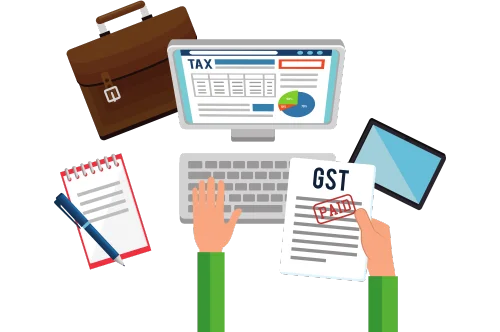How GST Slabs Hurt Small Businesses: A Breakdown of Complexity & Chaos
In India’s pursuit of a unified taxation system, the Goods and Services Tax (GST) was hailed as a revolutionary step toward simplifying indirect taxation. However, despite its intentions, GST has presented unexpected hurdles for small businesses. One of the most pressing issues has been the intricate structure of GST slabs, which has turned what was supposed to be a streamlined system into a labyrinth of confusion and compliance headaches.
This blog explores how GST slabs have hurt small businesses, breaking down the complexity and chaos created by a system that was designed to simplify.
Understanding the GST Slab Structure
Before delving into its impact, it’s essential to understand what GST slabs are. Under the Indian GST regime, goods and services are categorized under multiple tax rates—0%, 5%, 12%, 18%, and 28%. While the intention was to maintain revenue neutrality and keep essentials affordable, this multi-tiered structure has brought significant complications.
For small businesses that lack the resources to maintain specialized tax consultants or software, determining the correct GST slab for each product or service becomes a recurring nightmare.
1. Complexity in Classification
One of the most confusing aspects for small business owners is product and service classification. Many goods fall into gray areas where it’s difficult to decide which gst slab applies. Even minor differences in product description can shift a product from the 5% to 18% slab. This complexity causes fear of misclassification and potential penalties, leading to over-cautious or incorrect filings.
For example, if a business sells a packaged food product, it may attract 5% GST. However, a minor change in packaging or marketing can bump it into a higher GST slab, even though the core product remains the same.
2. Frequent Changes and Notifications
Another major hurdle is the frequent changes in gst slabs announced through notifications and circulars. The GST Council revises rates from time to time, leading to uncertainty for small business owners who already struggle with compliance. Unlike large corporations, small businesses may not have dedicated teams to track these changes, often resulting in delayed adaptation and incorrect tax payments.
These shifting gst slabs create a volatile pricing environment, affecting long-term planning, profitability, and inventory management.
3. Increased Compliance Burden
Each GST slab comes with its own compliance challenges. Businesses have to maintain meticulous records to prove they are charging the correct rate. The reconciliation of invoices, matching of returns (GSTR-1, GSTR-3B), and classification across multiple gst slabs significantly increase the compliance burden.
Moreover, if a business sells items across various gst slabs, the bookkeeping becomes even more complex. Many small businesses, particularly those in semi-urban and rural areas, struggle to find affordable accounting support, making compliance a stressful and error-prone process.
4. Input Tax Credit (ITC) Complications
One of the key features of GST is Input Tax Credit. However, businesses dealing with multiple gst slabs often face challenges in claiming full ITC. If the input is taxed at a higher rate and output is taxed at a lower slab, there’s an accumulation of credit that cannot be fully utilized.
This mismatch leads to working capital being stuck in the form of unutilized ITC, which is a major issue for small businesses already operating on thin margins. The complexity introduced by gst slabs disrupts cash flow and hampers growth potential.
5. Discouragement from Expansion
Because of the complications posed by gst slabs, many small entrepreneurs hesitate to expand their business or product lines. Adding new products means deciphering the applicable gst slab, adjusting pricing, and adapting to fresh compliance routines. This acts as a deterrent to growth.
For instance, a textile trader selling cotton garments (5%) may avoid adding synthetic blends if they fall into a higher GST slab, despite market demand. This slows innovation, market responsiveness, and economic dynamism among SMEs.
6. Disruption of Price Uniformity
One of the key goals of GST was to create a uniform market across India. However, the diverse gst slabs ironically create price disparities. Two businesses selling similar products may price them differently depending on their interpretation of the applicable slab. This inconsistency confuses consumers and affects small businesses that lose customers to competitors operating under a more favorable slab.
7. Penalties and Legal Risks
Small businesses often face notices and audits simply because they got the gst slab wrong. Misclassification—even if unintentional—can result in hefty fines, interest, and in some cases, even legal action. The lack of clarity around certain slabs only adds to the fear and risk.
In a complex tax ecosystem, the ones with fewer resources are more vulnerable. Large companies have legal departments to fight disputes, while small businesses are forced to settle or suffer losses.
8. Sector-Specific Anomalies
The gst slabs system has led to sector-specific distortions. Take restaurants as an example. Small standalone restaurants (with or without air conditioning) fall under different GST slabs compared to those operating inside hotels. This inconsistency gives rise to unfair competition and affects how small businesses structure their operations.
Another example is the handmade goods sector, where artisans are often subjected to different rates than machine-made alternatives, putting traditional craftspeople at a disadvantage.
9. Lack of Simplicity Defeats the Purpose
The biggest irony is that gst slabs, which were designed to preserve revenue and protect certain sectors, have made the system less simple. A simpler tax system with fewer slabs would not only reduce confusion but also encourage voluntary compliance and ease of doing business.
Small businesses, which form the backbone of India’s economy, are being bogged down by tax jargon, endless notifications, and fear of penalties—all rooted in the overly complicated gst slabs.
10. Need for Reform and Simplification
The government has acknowledged the challenges of multiple gst slabs but has yet to implement a comprehensive simplification. Experts have repeatedly suggested reducing the number of slabs to two or three. Doing so would:
Simplify compliance
Reduce classification disputes
Improve ITC utilization
Create a level playing field
Such reforms would be a game-changer for small businesses, making GST a truly business-friendly tax system.
Conclusion
The intention behind GST was noble—to simplify the tax regime and make India a unified market. However, the way gst slabs have been implemented has made life difficult for small businesses. Instead of empowering them, the system has buried them under paperwork, ambiguity, and fear.
To unlock the true potential of small businesses, the government must reconsider the design of gst slabs. Simplification, consistency, and clear guidelines are the need of the hour. Until then, India’s small businesses will continue to navigate the chaos created by a tax system that was meant to liberate them.
Our GST Services

All E-commerce Tax services
E-commerce tax services help online sellers navigate GST registration, compliance, return filing, TCS management, tax planning, and audits, ensuring efficient tax management and legal compliance.

GST Filing
GST filing is the process of submitting tax returns to the government, detailing sales, purchases, and taxes paid or collected, ensuring compliance with GST laws.

GST Registration
GST registration is the process where businesses obtain a GSTIN from the government, allowing them to collect taxes, claim input tax credits, and comply with GST laws.





